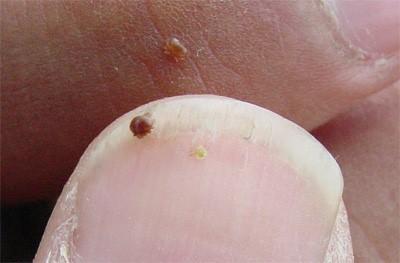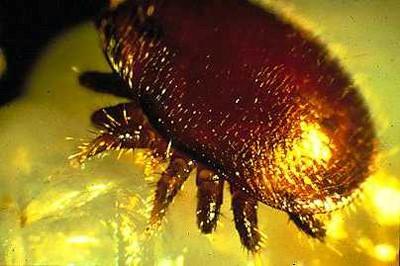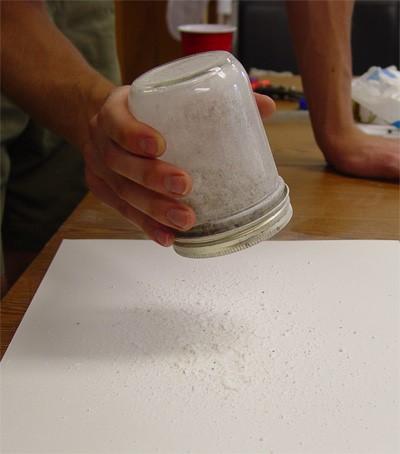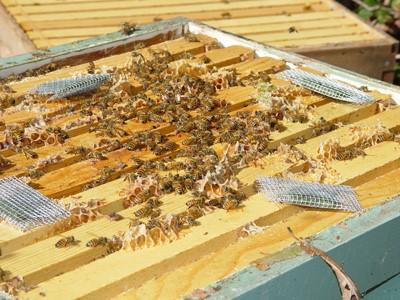Introduction
The Varroa mite (Varroa destructor) is the most serious pest of honey bee colonies worldwide. This parasite was first detected in North Carolina in 1990, having been introduced to the United States just 3 years earlier. Virtually all feral (or “wild-living”) honey bee colonies have all but been wiped out by these mites, and beekeepers continue to struggle with Varroa infestations in their hives. In North Carolina alone, the number of managed beehives has dropped by an estimated 44 percent since the invasion of the mites. It is vital, therefore, to understand the Varroa mite and the options available for its control.
Mite Biology
The mite is an external parasite, which attacks both adult bees and the developing honey bee larvae. The adult mites have a flattened oval shape, are reddish-brown in color, and are about 0.06 inches wide (about the size of the head of a pin). The mated female mite enters the cell of a developing bee larva and lays up to six eggs. The developing mites feed on the pupae and, depending on the number of mites, may kill it, cause it to be deformed, or have no visible effect. While the males die in the cell, the adult daughter mites climb onto an adult worker bee and feed on its fat bodies and hemolymph (bee “blood”). The female mite can then repeat the cycle by entering cells of other developing larvae.
Mites prefer drone larvae over worker larvae, but they will infest worker larvae and eventually kill the colony if preventative measures are not taken.
The mites can harm the bees indirectly as well. In addition to the obvious effects of mites feeding on developing and adult bees, the mites can also serve as vectors of several viruses that can kill bees. These secondary infections, facilitated by the mites compromising the bees’ immune systems, can cause a condition known as Parasitic Mite Syndrome (PMS), which can kill colonies within months of infestation. Deformed Wing Virus (DWV) is one such virus. This results with worker bees emerging from their cells with wings that appear mangled and misshapen. While DWV is the most common virus, it is just one of several dozen known viruses vectored by the Varroa mite.
Detection Methods
Many colonies that succumb to Varroa infestations will do so in the late summer or fall. It is difficult to simply inspect a colony and determine if it has a high level of mites. It is important, therefore, to sample colonies to estimate the degree of infestation.
Sugar Shake Method
This method estimates the mite load within the colony (the percentage of adult bees with mites).
-
Obtain a clear 1-pint jar or other container with a lid made from 1⁄8-inch hardware cloth or similar mesh material. If you cannot find a jar with a mesh lid, make a mesh lid for your container.
-
Shake adult bees from a frame with emerging brood into a shallow tub. Using a ½ cup measuring device, scoop up ½ cup of workers and place into the jar. (This is approximately 300 bees).
-
Close the mesh lid on the jar and add 2 to 3 tablespoons of powdered sugar through the lid.
-
Set the jar aside for several minutes to allow the bees (and mites) to be covered in sugar.
-
Shake the sugar (and dislodged mites) out of the jar onto clean, flat surface (preferably white). The bees, although covered in sugar, are not killed and can be returned to the colony. If 9 or more mites are found per 300 bees, then appropriate measures should be taken to control the mite population. A magnifying glass may be necessary to see the mites.
Alcohol Wash Method
Similar to the sugar roll, this method requires that the beekeeper shake adult bees into a clear container to measure the prevalence of Varroa mites.
-
Pour 1 to 2 inches of rubbing alcohol (isopropyl alcohol) into a clear 1-pint jar or container with a solid lid.
-
Shake adult bees from a frame with emerging brood into a shallow tub then scoop ½ cup of bees and place in the container. Close lid tightly.
-
Vigorously shake the container for at least 30 seconds and then examine the container for dead mites sinking to the bottom. If you see 9 or more mites per 300 bees, then you should take immediate action.
Sticky Board Method
This method estimates the total mite intensity of the colony (total number of mites in the hive).
-
Purchase a commercial sticky board from a beekeeping supply company, which has a pre- applied adhesive and sampling grid drawn on the surface. Alternatively, sticky boards may be constructed by placing a stiff sheet of white paper.
-
Spray the upper surface of the paper (facing the bees) with an aerosol cooking spray, or apply a thin layer of petroleum jelly to the upper surface of the paper to create a homemade sticky board.
-
Please the board or paper between two 8-mesh wire covers (with one cover on the top and one on the bottom) so that the bees do not adhere to the sticky surface.
-
Place the sticky board on the bottom floor of the hive. A portion of the mites will fall off the bees, fall through the mesh screen and stick to the white board.
-
Remove the board 24 hours later and count the total number of mites on it. If the number of mites is between 60 and 190 (depending on the size of the colony), then appropriate control measures should be taken.
Drone Brood Inspection
Because of the variation in sampling, this method is not always a reliable indicator of mite levels in a colony. However, it can be used to verify the relative degree of Varroa infestation.
-
Find any capped drone brood within the hive, which is typically located on the periphery of the brood nest.
-
Uncap the cells and gently remove the pupae.
-
Closely inspect the drone pupae for adult varroa mites. If 10 percent or more of the drones are infested, then you should take appropriate measures to reduce the mite population.
Current recommendations are to monitor all honey bee colonies for Varroa mite infestation, preferably numerous times over the course of a season, to determine if and when action is necessary. It is also recommended that multiple sampling techniques are employed to make sure that an accurate measure is obtained for each colony.
Controlling Varroa Mites
Traditional methods for Varroa mite control have been to hang plastic strips impregnated with chemical pesticides between the wax combs of bee hives (see below). Unfortunately, and perhaps inevitably, the mites are rapidly developing resistances to many of the common acaricides, which has prompted researchers to develop numerous alternative methods to prevent and control Varroa mite infestations. These methods range from structural or mechanical changes to beehives, to new stocks that are more resistant to mites, to bio-pesticides that are valuable alternatives to the standard synthetic chemicals.
Mechanical Control
Certain control methods involve changes in the management practices of beekeeping. The benefit of such mechanical control measures is that they do not use chemicals to reduce mite levels, thus they may be employed even during times when the bees are collecting and producing honey. They may, however, be more laborious or require new equipment, and they may not be as effective as other control measures.
Screened Bottom Boards
Research has shown some benefit of replacing the wooden bottom of a standard bee hive with a wire-mesh screen or other non-solid surface. Several studies have shown numerical decreases in mite levels of colonies using screened bottoms compared to solid bottoms. While the reasons for this decrease is unknown, it may be due to better hive ventilation or to the loss of mites inadvertently dropping through the floor of the hive. The benefits of bottom screens are minimal, however, and usually require additional methods of control.
Drone-Brood Trapping
Varroa mites prefer to infest drone brood, which are the developing pupae of male honey bees. This is because drones are larger and take longer to develop, so that female mites can produce more offspring per generation. Beekeepers may take advantage of this preference by placing special combs with drone-sized cells in their hives to attract mites to the brood. These combs can then be removed before the drones—and the mites—emerge from their cells. Depending on the time of year, this practice can dramatically reduce the mite populations within colonies.
Mite-Resistant Stocks
Some of the more exciting advances in Varroa mite control has been in honey bee genetics. In recent years, much work has been done with the development of particular strains of honey bees that have shown higher resistance to the Varroa mite. Though the mechanisms are not completely understood, some behavioral and physiological traits likely play a role in Varroa resistance. Today, several strains of bees are available that have been shown to reduce the number of varroa mites within their colonies.
Russian Strain
Researchers at the USDA Honey Bee Research Lab in Baton Rouge, Louisiana have imported bees from the Primorsky region in far-eastern Russia because they co-exist with the original host species of varroa (the sister honey-bee species, Apis cerana). Because these Russian bees have been exposed to the mite for a longer period compared to other strains, it follows that they may have developed a resistance to the mite. Indeed, research has shown that they are over twice as resistant to Varroa as other commercial stocks. Moreover, for reasons that are yet unclear, this stock appears to be highly resistant to the tracheal mites, a second parasitic mite that infests honey bee colonies. The Russian strain has been made available for commercial purchase in the U.S. after a protracted period in quarantine.
VSH Stock
Standing for Varroa Sensitive Hygiene, this trait was selected for by USDA researchers using classical bee breeding and instrumental insemination techniques. The bees have been selected to detect varroa mites in the cells of developing pupae and remove them before the mites can reproduce. This stock has been crossed with other, more common commercial stocks in an attempt to integrate this useful trait into other bee strains.
Hygienic Behavior
Many queen breeders have actively bred for colony brood-nest “cleanliness” or hygienic behavior. Much research has demonstrated lower levels of numerous diseases in colonies selectively bred to uncap and removed diseased or parasitized brood (e.g., the Minnesota Hygienic stock). While these stocks are not immune to varroa parasitism, they may significantly reduce the need for other control methods.
Bio-Pesticides
Biopesticides are defined as naturally occurring organisms or their by-products, and several have been registered for controlling Varroa mites in honey bee colonies. The efficacy of many biopesticides can equal to that of conventional chemical pesticides. However, the delivery of these chemicals can be quite different, and understanding these differences is important to insure successful control of Varroa.
Apilife VAR®
This product—containing a combination of the essential oils thymol, eucalyptol, and menthol—has been approved by the US Environmental Protection Agency (EPA) for its use in North Carolina to treat both varroa and tracheal mites. Several studies have shown between 65% and 97% effectiveness at killing varroa mites. The delivery medium of this product is a vermiculite tablet, which must be broken into four pieces and placed in the four corners of the hive between the brood chambers. New tablets must be used every week for 3 weeks for complete effectiveness. The effectiveness of Apilife VAR® is temperature dependent and can only be used effectively in temperatures above 60°F and below 90°F. The product may cause significant mortality of bee brood, thus it may be most useful as a fall treatment when brood rearing naturally declines.
Apiguard
Thymol is also the active ingredient in Apiguard®, although the delivery system is different from Apilife VAR. With Apiguard, a tray of slow-release gel is placed in the center above the brood nest. It is necessary to provide space of ½ inch or more to allow for the gel to release over the entire brood nest. A second application needs to be done after 14 days to successfully treat an entire brood cycle. The appropriate temperature range for use of Apiguard is between 60°F and 100°F. It should not be used while honey supers are on a hive, and it is recommended to wait 10 days before replacing supers.
Formic Acid
Formic acid is an approved method of Varroa control in the United States. This method has been used by beekeepers in Canada and Europe for many years, and it is the only chemical pesticide that can be used for organic honey production. There are several delivery methods for formic acid, such as placing pads soaked with liquid formic acid on top of the hive (by the trade name Formic Pro®). The product cannot be used during a honey flow, and the daily high temperatures must be between 50°F and 79°F. If temperatures exceed 82°F during the first week of treatment, it must be removed from the hive as it may result in a significant loss of brood and adult bees. Small colonies (fewer than six frames of bees) can themselves be overwhelmed by the fumes. Care must also be taken by the beekeeper while applying formic acid, as it is highly corrosive and poisonous to humans, thus proper precautions must be taken to avoid exposure.
Api-Bioxal®
Api-Bioxal®, with the active ingredient of oxalic acid dihydrate, has become a common tool used by beekeepers for controlling Varroa. It comes in a crystal formation and may be applied to bees in two main ways, either as a liquid or as a vapor. It is important note that oxalic acid (OA) is not effective at killing mites underneath cappings, therefore it is best to apply OA during a time of broodlessness. Going into winter is an ideal time to apply OA since this is a time when honey bees are naturally brooding down.
For a better explanation of the different methods, see the Beekeeping Note 2.18, Oxalic Acid for Controlling Varroa Mites.
Chemical (Synthetic Pesticide) Acaricides
Conventional means of Varroa control involve synthetic pesticides being administered to a colony by placing plastic strips impregnated with the active chemical within the hive. While these treatments have traditionally provided very high levels of control, there is an increasing prevalence of resistance to these chemicals which makes them less reliable.
Apistan®
One of the first pesticides to be registered by the EPA for the control of Varroa mites was Apistan®, the trade name for fluvalinate (a synthetic pyrethroid). It is sold as a plastic strip impregnated with the active pesticide, and the strips are hung between the frames of a hive just outside of the brood nest. Fluvalinate is a contact pesticide and provides up to 100% control of varroa mites when properly used. In recent years, however, there has been increasing reports of varroa mites developing resistance to this pesticide. It is highly recommended, therefore, that Apistan® be rotated with other treatments to reduce the development of resistance to chemical control by the mites and to ensure its efficacy.
Apivar®
Apivar is similar to Apistan® where the product is a plastic strip impregnated with an active pesticide, but in this case the active ingredient is amitraz. This too has been used for many years and although it was once an effective treatment, it has recently proven to be less effective. The Varroa mites have been shown to have developed a resistance to this product, so this is not being recommended as a treatment at this time.
Checkmite+®
Largely in response to fluvalinate resistance, the EPA registered another synthetic chemical as a Section 18 emergency-use pesticide for varroa control. Checkmite+®, the trade name for coumaphos, is also sold as a plastic strip impregnated with the active pesticide that, when the bees and mites into contact with it, can provide up to 100% control when used properly. Coumaphos is a member of the organophosphate group of pesticides, and residues can accumulate in wax and be harmful to bees at high levels. For this reason, it is no longer recommended. Just as with Apistan®, there have been documented cases of Varroa mites developing resistance to this pesticide, so it is important to use it according to label directions and to alternate its use with other approved treatments. Checkmite+® is also registered for the control of the small hive beetle (Athena tumida), although it is no longer promoted as it has not proven to be effective.
Summary
-
Varroa mites are currently the greatest threat to beekeepers and their colonies, and infested colonies will probably perish if action is not taken to control mite levels. Thus, they are a significant threat to a beekeeper's income and colony health.
-
Monitoring hives for mite levels enable beekeepers to determine whether treatment is necessary and to make informed decisions about when to take action.
-
The exclusive and continual use of one chemical product is more likely to result in the development of resistance by the mites. Several different products should be used on a rotating basis.
-
Do NOT, under any circumstances, experiment with non-approved chemical treatments. Such practices are illegal and may result in bee death, the contamination of honey and wax, and severe harm to the beekeeper.
-
Because of the inherent risks with the use of chemical pesticides, and the fact that some of the available treatments can only be obtained by individuals with a current pesticide certification, it is recommended that all beekeepers receive training and certification through the NCDA&CS Pesticide Licensing Program.
-
For additional information or assistance, contact your local NCDA&CS bee inspector, your local N.C. Cooperative Extension Center, or the Apicultural Program at NC State University.
|
Management Method |
Chemical (if applicable) |
Relative Effectiveness |
Degree of Manipulation |
Other Pests Controlled |
License Required |
|---|---|---|---|---|---|
|
Screened bottom board |
- |
Low |
Low |
- |
- |
|
Drone brood trapping |
- |
Moderate |
Moderate |
- |
- |
|
Inert dusts |
- |
Moderate |
High |
- |
- |
|
Mite-tolerant stocks |
- |
Moderate |
Low |
TM‡ |
- |
|
Apilife VAR® |
Thymol |
Moderate- High |
Moderate |
TM |
Yes |
|
ApiBioxal® |
Oxalic Acid |
High (broodless) |
Low |
- |
- |
|
Formic Pro |
Formic acid |
High |
Moderate |
TM |
- |
|
Apistan® |
Fluvalinate |
High* |
Low |
- |
- |
|
CheckMite+® |
Coumaphos |
High* |
Low |
SHB |
Yes |
|
* In areas where resistance has not developed↵; TM = tracheal mite; SHB = small hive beetle ↲ ‡ For Russian strain only ↲ |
|||||
This project received support from the Golden LEAF Foundation.
For More Information
North Carolina Department of Agriculture & Consumer Services, Apiary Inspection
North Carolina State University Apiculture Program
For more information on beekeeping, visit the Beekeeping Notes website.
|
David R. Tarpy Professor and Extension Apiculturist Department of Applied Ecology, Campus Box 7617 North Carolina State University Raleigh, NC 27695-7617 TEL: (919) 515-1660 FAX: (919) 515-7746 EMAIL: david_tarpy@ncsu.edu |
Jennifer J. Keller Extension and Outreach Coordinator Department of Applied Ecology, Campus Box 7617 North Carolina State University Raleigh, NC 27695-7617 TEL: (919) 513-3967 FAX: (919) 515-7746 EMAIL: jennifer_keller@ncsu.edu |
Publication date: Dec. 19, 2025
Recommendations for the use of agricultural chemicals are included in this publication as a convenience to the reader. The use of brand names and any mention or listing of commercial products or services in this publication does not imply endorsement by NC State University or N.C. A&T State University nor discrimination against similar products or services not mentioned. Individuals who use agricultural chemicals are responsible for ensuring that the intended use complies with current regulations and conforms to the product label. Be sure to obtain current information about usage regulations and examine a current product label before applying any chemical. For assistance, contact your local N.C. Cooperative Extension county center.
N.C. Cooperative Extension prohibits discrimination and harassment regardless of age, color, disability, family and marital status, gender identity, national origin, political beliefs, race, religion, sex (including pregnancy), sexual orientation and veteran status.







